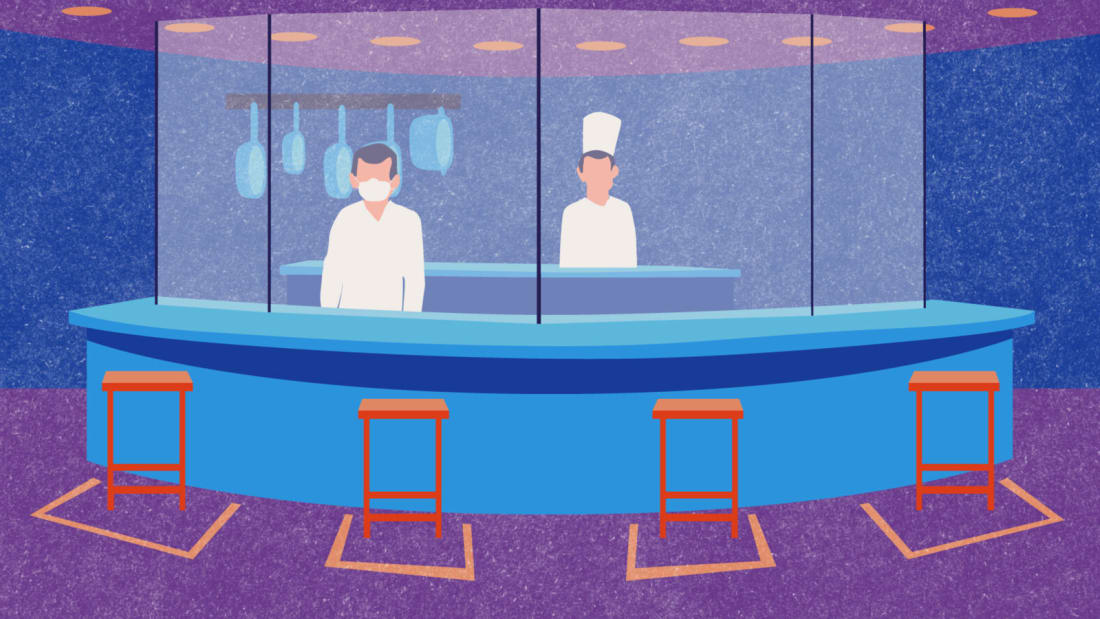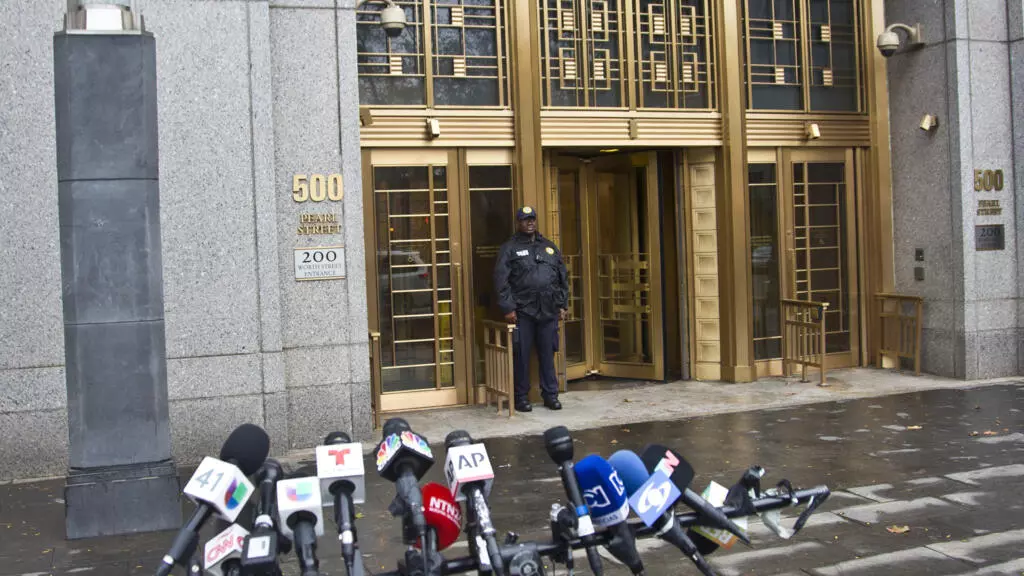
This article is more than
5 year oldWhat eating in a restaurant may look like during the pandemic

(CNN) — Michelin-starred meals via delivery. Instagram Live cooking demos. Gourmet boxes from community supported agriculture.
While the country's restaurant industry has proved nimble in finding new ways to stay afloat with dining rooms closed to customers, the announcement in late April from the state of Georgia permitting reopenings sent a slim beam of light through these dark times. Now as more states begin reopening, there's an increased concern over protocols for keeping everyone safe and healthy.
And given the safety precautions that will need to be put in place, post-pandemic dining is going to look very different than a couple of months ago.
Although obviously eager to get back to work, the operators CNN spoke with don't plan on resuming service anytime in the near future.
Although obviously eager to get back to work, the operators CNN spoke with don't plan on resuming service anytime in the near future.
"The safety and health of our guests, employees, and community are our highest priority, and until we have more information that we are not putting anyone in an unsafe or uncomfortable environment, we will keep our doors closed," wrote Justin Anthony of True Story Brands restaurant group in Georgia in an email.
“Although obviously eager to get back to work, the operators CNN spoke with don't plan on resuming service anytime in the near future.”
However, they are considering what dining looks like once it feels like the pandemic is under control. Hong Kong offers a few glimpses.
At Yardbird, a host takes a guest's temperature before the diner is allowed to enter the dining room, which is operating at half capacity. The ubiquitous masks worn by the staff remind patrons that even if drinks are flowing and dishes are flying out of the kitchen, the true nature of the restaurant is in hiding until the pandemic is no longer a threat.
But while the international restaurant scene may offer a peek at what's the come, the US's navigation probably won't follow the exact same route.
"This is an industry that for decades has been highly regulated," says Larry Lynch, senior vice president of science and industry for the National Restaurant Association, which released detailed reopening guidelines on April 22.
"We've been very steadfast and sticking with guidance coming from the Center for Disease Control, US Food and Drug Administration and Environmental Protection Agency, and working with all agencies to create guidelines for restaurants. [However, restaurants] have to operationalize it. Guidance is just that. It's pointing you in the direction."
State-by-state safety mandates will likely will provide further clarification. The ones released by the state of Georgia on April 23 noted capacity restrictions and banned salad bar and buffet stations, for example.
While awaiting more information from the top, internal communications throughout the industry also help restaurateurs prep for the big day.
The James Beard Foundation hosts regular webinars, such as one titled "Updated Food Safety and Sanitation Guidelines," and The American Culinary Foundation offers an Covid-19 sanitation course free for ACF members and nonmembers.
Rethinking the space
Allison Cooke, principal and director of hospitality design at Core, a hospitality design firm based in Washington, DC, works with clients to get their spaces ready for reopening.
"We always look at what are the operational characteristics they need to achieve and functionalities," she says. She's aiding restaurants across the country with "simple strategies that they could implement that are low cost and will make their spaces safer."
The first major change to restaurants will be capacity. To maintain distance, restaurateurs plan to start at 50% maximum, a concept many first flirted with weeks ago before regulations shut down dining rooms completely.
Communal tables may only hold parties of two at either end, or one party of four in the middle.
When it comes to banquette seating for two, both people may end up the cushy seat. Cooke says it will be safer for servers if both parties sit facing outward, so the server doesn't need to slide in between tables in order to reach the far-seated guest.
Identifying points of congestion and finding flow will positively affect how people safely move around the space.
Cooke notes certain pathways, such as hallways to the bathroom, tend to intersect with heavily trafficked spaces, such as kitchen entrances, and need to be looked at.
"Operationally, do you assign a hall monitor or someone to keep an eye out for guests?" she half-jokes. "I think a lot of it goes to the communication and messaging that customers get before they even enter a restaurant and what the new kind of expectation for respecting space feels like and should be."
And communication will be key. Signage is the new artwork, reminding guests to be respectful of others, to maintain space and reinforce safety protocol. Markers indicating six feet may dot the floors.
While open kitchens — built-in theater, essentially — used to be a draw, Plexiglas barriers might be installed. The intimate exchanges at a chef's counter experience could also be corralled by Plexiglas.
Stephanie Castellucci, owner of the six-restaurant strong Castellucci Group in Georgia, is working with Cooke on making her restaurants safe spaces. She's considering installing Plexiglas barriers by tables that sit in higher-traffic spots, such as at a server's POS (point of sale) station.
Every minor detail and every touch point needs to be considered. Along with constantly sanitizing all surfaces, Castellucci plans on installing automatic soap dispensers, trash cans and door openers, in an effort to get rid of "all the things you would put your hands on," she says.
Caring for employees
Like Jennifer Aniston's character in the movie "Office Space," uniforms are going to require a lot more flair. Restaurateurs will mandate personal protective equipment (PPE) such as gloves and masks for all employees.
Frequent hand-washing — part of standard protocol — remains vital. Sarah Gavigan, chef and owner of The Otaku Group in Nashville, plans to check staff members' temperatures upon their arrival to work.
Given the size of many restaurant kitchens, cooking is often part food prep and part dance.
"People are working very tight quarters in the kitchens," notes Carey Ferrara, director of sales and marketing for The Gaslight Group in Savannah, Georgia. "How will you maintain that six-foot distance between people?"
She thinks it "will probably lead to a little bit longer times for food to come out," and admits that six feet may not be completely possible at all times.
“Luckily, red-faced, foul-mouthed, screaming chefs are no longer tolerated, but their brief glamourization revealed how important verbal communication is in a kitchen setting. ”
Luckily, red-faced, foul-mouthed, screaming chefs are no longer tolerated, but their brief heyday revealed how important verbal communication is in a kitchen setting.
Clear and concise messages among the chefs and between the kitchen team and servers keep service flowing smoothly; however, according it Castellucci, "it's difficult in a normal environment, and then you add those additional precautions [of masks and a six-foot distance] on top of that, and it does provide the opportunity for things to get missed. So we're thinking about how we can work more off of [order] tickets and less off of calls."
Altered ambiance
Get ready for culture shock: Ambiance at a favorite restaurant may be unrecognizable, at least in the beginning.
"There's going to be some things that have to happen that make restaurants probably a little less pretty and a little less lively and take away some of the ambiance that we all crave when we go out," says Scott Shor, operating partner at Edmund's Oast, a vibrant restaurant and brewery in Charleston, South Carolina. "But the new reality — at least in the short term — might just be that it has to look a little bit more industrial and a little bit more carefully plotted out."
To ensure guests eat with the cleanest utensils and drink out of pristine glasses, tables may not get set until diners take a seat.
Many restaurateurs grapple with the idea of utilizing disposable dishware as they think about reopening. The sustainability aspect leaves them cold, but it could provide temporary peace of mind. Salt, pepper, ketchup and other accoutrements will be served only upon request. In their place, look for hand sanitizer.
Fewer diners could mean a quieter restaurant chatter-wise, but communication between server and diners — especially at six feet away and through masks — may result in higher volumes.
"Tableside, how do we distance while still taking orders while still delivering great service," ponders Shor. "It's not going to be perfect because someone has to pick up and put stuff down on the table. You can't stay six feet back and run food to the table and pick up and clear the dishes."
While sharing plates and family-style dishes ruled menus pre-pandemic, chefs now consider diners' comfort levels with this preparation.
David Schuttenberg and Tina Heath-Schuttenberg, co-owners of the popular Kwei Fei in Charleston, South Carolina, "could see a scenario where we add a modifier [a special instruction in our order system] and portion things out in the kitchen." However, both hate to lose the communal dining experience. "It's a core part of who we are," says Schuttenberg.
No matter how much planning goes into the redesign, all owners acknowledge they won't know what works and what feels right until they're operational(ish).
Castellucci plans on offering gloves and masks to guests upon arrival, but Shor notes logistically it doesn't work if you're a diner as "you have to have access to your nose and mouth."
Read More (...)



